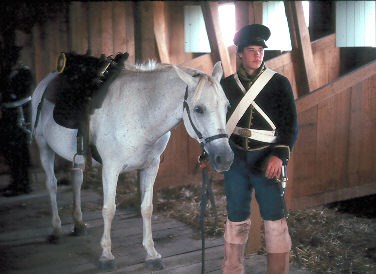
During the 1840s, the treatment of sick horses was limited to the practical experience of the dragoons because the Veterinary Department was not established until early in the twentieth century. If a horse contracted a contagious disease such as farcy or glanders, it was isolated from the other horses and if the disease could not be cured, the animal was destroyed. The following list identifies the prevalent diseases, ailments and treatments of the dragoon horses.
No contagious disease was feared more than glanders. Farcy, which often accompanied glanders, was equally devastating. Horses which showed the slightest symptoms of either were quickly isolated to protect the healthy animals. No treatment could be relied on to cure farcy; and since it was as contagious as glanders, every farcied horse had to be destroyed as soon as possible. Oil of Spike, Blue-stone (blue vitriol) and Glauber salts, remedies for glanders, are identified in the returns for Fort Scott as having been expended for diseased animals, suggesting there may have been an outbreak among the horses.
Tar had a number of uses. A tablespoon of tar was placed on the back of a horse's tongue to prevent colds, catarrh, and distemper. It also was used when horses were transferred from the stables to the fields. Tar was applied over or around wounds to repel flies and could be used with oakum as a hoof pack.
Sore backs usually occurred when the blanket was not properly folded under the saddle or from careless riding. For saddling and packing a horse there were specific instructions in the manual. On marches, a trooper made every effort to see his saddle blanket was dry when put next to the horse, since a wet blanket and resultant sore back could mean days of walking beside a mount. Officers were cautioned to observe the riding habits of their men, so that weight was distributed evenly. Oil of Spike and Castile soap were mentioned as specific remedies at Fort Scott for galled horses. Sprains and spavins were treated with two kinds of liniments, "Lindseys" and one identified only as "Nerve and Bone." The information for this section was taken from the Historic Furnishing Report for The Dragoon Stables by Sally Johnson Ketchum and from an article in Fort Scott's files called Horses of the United States Dragoons. |
Last updated: July 25, 2016

